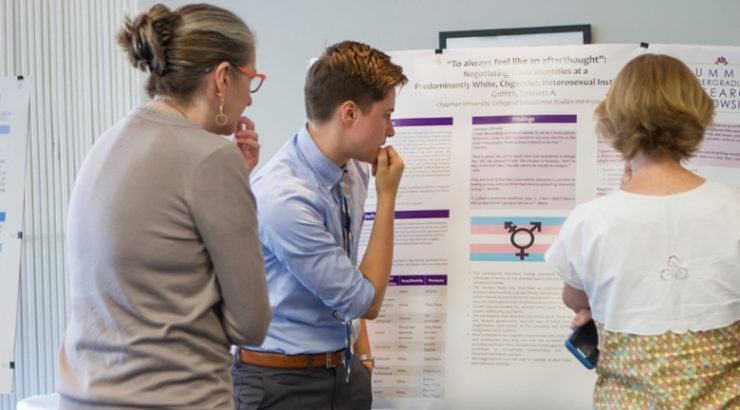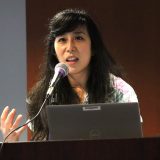
Personalized Education in Action: SURF Summer Research
August 19, 2021
By Talisa Flores and Samantha De La O
British radio dramas, protest art in dance choreography, and the gender gap in computer science are just three of the diverse topics explored by the five Wilkinson College students selected to participate in the Summer Undergraduate Research Fellowship (SURF) program this year.
“There is something wonderful about the opportunity to collaborate with an individual undergraduate researcher through the SURF program at Chapman,” says Dr. Jan Osborn, English professor, and SURF faculty mentor. “Working closely with one student over the course of the summer deepens the student’s understanding of the research process and facilitates a collaborative process for both the faculty and the student. This is what a personalized education of distinction is all about.”
SURF is a competitive 8-week summer program that offers Chapman University undergraduate students experience in hands-on research and creative scholarship mentored by expert faculty. All SURF fellows are given the opportunity to participate in a faculty’s ongoing research/creative program or can craft a unique project in their area of interest. Among the 2021 SURF fellows were Wilkinson College students Lauren Bramlett (English), Roksana Gorgolewski (Political Science/Peace Studies), Nat Pendergraft (History), Cindy Ramirez (Writing and Rhetorical Studies), and Nathan Reynoso (Creative Writing).
On August 5th, each SURF student presented their project at a summer research conference.
“Though I was melting with nervousness at the Conference to present a 2-minute flash talk of my project to over 100 people in the Zoom room, it was such a delight to see my peers, other members of faculty, and previous SURF fellows engage in this ongoing dialogue of questions, analysis, and truth,” said SURF fellow Nathan Reynoso, who conducted his research on British Radio Dramas. “SURF has given me the time and patience to read over 16 texts, collaborate with an archive centre in England, and develop the confidence to pursue my creative and scholarly endeavors in the future.”
“Before SURF, I’d never had the chance to conduct long-term research under the supervision of a professor,” said SURF fellow Lauren Bramlet, who conducted research on protest art in choreography. “I didn’t understand the possibilities of research in humanities and creative arts fields until the last couple of years, but as soon as I realized they existed I was intrigued. Being a part of SURF allowed me to dive into a topic that I’m interested in with the resources, time, and guidance that I needed – now I know that I want research to be a part of my life regardless of what professional direction I go in. As a double major in dance and English, there isn’t much overlap between my fields in a way that feels obvious—at least career-wise—but I’m passionate about both and wanted to pursue a project that incorporated both my academic and creative interests.”
Take a look at each student’s research project!
Lauren Bramlett
Faculty Mentor: Julianne O’Brien
Major/Minor: BFA Dance Performance; BA English Literature, Rhetoric, and Cultural Studies
Title: Movement Matters: The Rhetorical Power of Dancing Bodies
Abstract: This project observes examples of protest art in concert dance choreography during the latter half of the 20th century. The study seeks to understand choreographers’ usage of bodily movement as a form of activism, observing how and why bodies act as rhetorical agents. Using Mikhail Bakhtin’s theory of dialogism in conjunction with the theory of new materialism–specifically as it is situated by Laurie Gries and Rosi Braidotti–the project takes a joint methodological approach to rhetorically analyze dance pieces with a focus on dialogic relationships, affect, spatiality, and temporality. Through both analysis of dance artifacts and embodied practice of movement, the project questions where rhetorical power exists within the dance and the dancer’s body. Movement research Further, the project asks how the dancer’s body interacts with its surroundings and how such interaction produces meaning, observing the dialogic relationship between all material present in the situation. The movement of dancers functions to contribute to the movement of social change, revealing the human body as an accessible and effective vehicle of rhetorical power.
Roksana Gorgolewski
Faculty Mentor: Dr. Lisa Lietz
Major/Minor: Economics, Political Science, Peace Studies
Title: How new constitutions and conflict can support gender parity in legislatures
Abstract: In the past thirty years, a global trend of democratization and greater gender parity has influenced nations to rewrite their constitutions, putting more of an emphasis on equality among the sexes. The 1980’s in particular is cited with hosting a newfound constitutionalism. Reading Amrita Basu’s Women’s Movements in the Global Era:The Power of Local Feminisms and M.E. Berry’s War, Women, and Power: From violence to mobilization in Rwanda and Bosnia-Herzegovina highlights the unique opportunity time post-conflict offers to disrupt existing gender roles. This project explores determinants of gender parity in national legislatures among nations with newly ratified constitutions, adding a focus on the particular function conflict plays regarding gender quotas and constitutional re-working. Each nation analyzed either experienced significant conflict between 1989-2019 and ratified a new constitution between the same range. Other variables which aid this inquiry include the measures of gender inequality, political rights score, and the intensity of conflict. The methodology rests upon quantitative research. An original dataset was created, looking at fifty-six nations with newly ratified constitutions, taking variable data from Uppsala University, the World Bank, International IDEA, and the University of Michigan, among others. The project uses regression analysis to determine correlations and potential causes of gender disparity among national legislators. Expected results would conclude that in nations that rewrote their constitutions to include a gender quota and experienced conflict, which lead to the writing of the constitution, women hold a greater role in national legislatures by holding onto greater percentages of seats.
Nat Pendergraft
Faculty Mentor: Dr. Alexander Bay
Major/Minor: History and TV Writing and Production
Title: The Doctor is In: An Interactive Tour of Medical History
Abstract: To create an interactive experience for the audience member, actors will portray doctors from different time periods and places to showcase all the varied ways we have tried to treat different ailments. Specific diagnoses and treatment plans will be given to participants based on symptoms and the dominant medical theory of the era. By learning about the ways humans have used medicine in the past, modern individuals can recognize damaging patterns and logical fallacies that often influence medicine to this day. The first step to solving present day issues in the medical field is understanding their origin. Both educational and entertaining, this exhibit is meant to interest people in the world of history and share interesting facts with the lay public.
Cindy Ramirez
Faculty Mentor: Dr. Jan Osborn
Major/Minor: Software Engineering / Writing and Rhetorical Studies
Title: Gender Gap in Computer Science: An Invitational Rhetorical Analysis
Abstract: Even though computers were not yet invented, women have contributed to the field of computer science beginning in the 19th century. Considered the world’s first programmer, Ada Lovelace pioneered modern computer science concepts (1843), including concepts we use today, like variables and looping (Scully, 2016). Grace Hopper, an American computer scientist and U.S. Navy Rear Admiral, invented the first compiler for a computer programming language. While many women played important roles in computer science, the statistics of women majoring in computer science have declined. Although the 1980s saw the growth of personal computers in U.S homes, the number of women in computer science began to decrease (National Center for Education Statistics). These early computers were marketed as toys for males. With the media catering to males, movies like Weird Science and Revenge of the Nerds established a male environment and a “geek” culture in the field of computer science. In this study, I address the gender gap in computer science through a discourse analysis of materials used to attract young girls to the field. Applying Invitational Rhetoric, Foss and Griffin’s feminist rhetorical theory, I determine how rhetoric is used to attract or possibly dissuade young women from entering computer science. Conducting a literature review on the gender gap in computer science, researching statistics on women’s graduation rates in STEM fields, and identifying recurring themes such as stereotypes, grounded this study to show why women do not major in computer science. The findings provide a new understanding of the gender gap in computer science and provide specific rhetorical techniques to eliminate this gap.
“There is something wonderful about the opportunity to collaborate with an individual undergraduate researcher through the SURF program at Chapman. Working closely with one student over the course of the summer deepens the student’s understanding of the research process and facilitates a collaborative process for both the faculty and the student. This is what a personalized education of distinction is all about.”
Nathan Reynoso
Faculty Mentor: Dr. Jocelyn L. Buckner
Major/Minor: BFA Creative Writing, BA Theatre
Title: Rebuilding Identities: British radio dramas in the late ‘40s and ‘50s
Abstract: Despite the United Kingdom’s victory over the Axis powers in 1945, the country had a new enemy to fight at home: recovery. Specifically, the U.K. faced a £35 million debt; one in three households were bombed; 60,595 civilians were killed; and ongoing food rationing. Given these conditions, how could a war-torn U.K. unite and rebuild its country’s strength? What was affordable to manifest the identities of England, Scotland, Wales, and Northern Ireland to stimulate national pride? And what would it mean to be British in the post-War era? Within the paradigms of Benedict Anderson’s concept of “imagined communities,” I demonstrate how post-War radio dramas broadcast by the British Broadcasting Corporation (BBC) contributed to the development of a classless society with a reawakening of regionalism as a medium to express national unity. By analyzing two radio dramas from each nation in the U.K., I expose the reconstruction of their identities in the productions’ script (i.e., plot, language, cast, and stage directions) and aural elements (i.e., accents, SFXs, and music). These auditory performances in the late ‘40s and ‘50s were not just a medium for entertainment but products of print-welfarism that represented the “nation-ness” of the U.K. and reshaped post-War British society.






